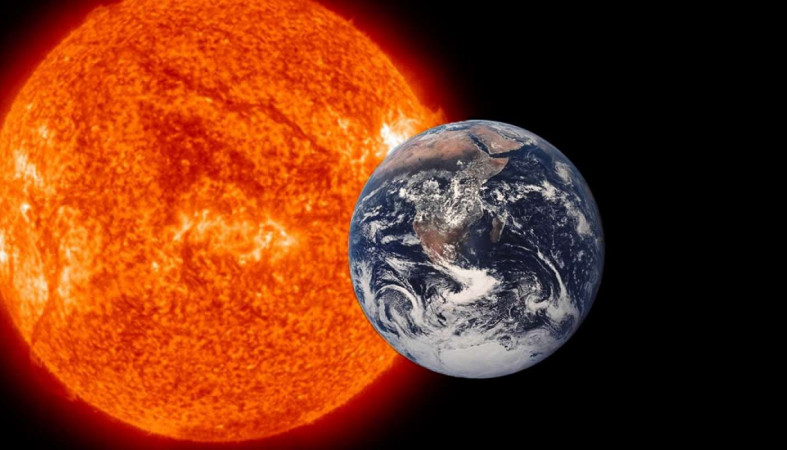кандидаты на роль обитаемого мира: астрономы нашли близнецов Земли и Солнца
Опубликовано 2020-06-07 18:00

Лучшие кандидаты на роль обитаемого мира: астрономы нашли близнецов Земли и Солнца
Об удивительном открытие сообщали астрономы из немецкого Института исследований Солнечной системы Общества Макса Планка. Они нашли в созвездии Лиры первую потенциально обитаемую планету, расположенную в системе звезды солнечного типа.
Речь идет о желтом карлике Kepler-160, который постоянно наблюдался телескопом "Кеплер" с 2009 по 2013 год. Звезда имеет массу в 0,9 массы Солнца, радиус — 1,1 его радиуса, а светимость практически такая же, как у Солнца.
"Кеплер" тогда нашел у этой звезды две планеты - Kepler-160b и Kepler-160c. Обе значительно больше Земли и находятся слишком близко к светилу, чтобы быть обитаемыми. Позднее нашлась и третья - Kepler-160d. Ее масса составляет от 1 до 100 масс Земли, а период обращения — от 7 до 50 земных суток.
Теперь же астрономы обнаружили, что в этой планетной системе есть и четвертый объект, очень похожий на Землю. Планете присвоили код KOI-456.04, ее радиус оценивается всего в 1,9 радиуса Земли, причем полный оборот по орбите она делает за 378 суток. Таким образом, KOI-456.04 удивительно близка к нашему привычному миру, и сама по себе, и по характеристикам своей звезды. Эта невероятно редкая комбинация делает экзопланету одним из лучших кандидатов на роль обитаемого мира.
По словам авторов исследования, опубликованного в журнале Astronomy & Astrophysics, до сих пор не было известно ни одной подобной далекой систем
Transit least-squares survey
A 1.9 R⊕ transit candidate in the habitable zone of Kepler-160 and a nontransiting planet characterized by transit-timing variations
Received: 16 October 2019 Accepted: 3 May 2020
The Sun-like star Kepler-160 (KOI-456) has been known to host two transiting planets, Kepler-160 b and c, of which planet c shows substantial transit-timing variations (TTVs). We studied the transit photometry and the TTVs of this system in our search for a suspected third planet. We used the archival Kepler photometry of Kepler-160 to search for additional transiting planets using a combination of our Wōtan detrending algorithm and our transit least-squares detection algorithm. We also used the Mercury N-body gravity code to study the orbital dynamics of the system in trying to explain the observed TTVs of planet c. First, we recovered the known transit series of planets Kepler-160 b and c. Then we found a new transiting candidate with a radius of 1.91−0.14+0.17 Earth radii (R⊕), an orbital period of 378.417−0.025+0.028 d, and Earth-like insolation. The vespa software predicts that this signal has an astrophysical false-positive probability of FPP3 = 1.8 × 10−3 when the multiplicity of the system is taken into account. Kepler vetting diagnostics yield a multiple event statistic of MES = 10.7, which corresponds to an ~85% reliability against false alarms due to instrumental artifacts such as rolling bands. We are also able to explain the observed TTVs of planet c with the presence of a previously unknown planet. The period and mass of this new planet, however, do not match the period and mass of the new transit candidate. Our Markov chain Monte Carlo simulations of the TTVs of Kepler-160 c can be conclusively explained by a new nontransiting planet with a mass between about 1 and 100 Earth masses and an orbital period between about 7 and 50 d. We conclude that Kepler-160 has at least three planets, one of which is the nontransiting planet Kepler-160 d. The expected stellar radial velocity amplitude caused by this new planet ranges between about 1 and 20 m s−1. We also find the super-Earth-sized transiting planet candidate KOI-456.04 in the habitable zone of this system, which could be the fourth planet.
|
Оставлять комментарии могут только зарегистрированные пользователи. Войдите в систему используя свою учетную запись на сайте: |
||
 1 New Concepts in Science*
1 New Concepts in Science*